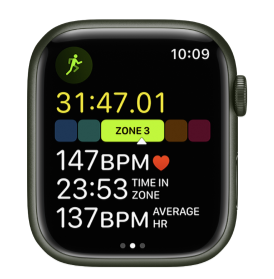It's a myth that you have to train hard to see great results. The proof is Zone 2 training.
Zone 2 training is awesome. Your body just loves it—It burns fat, repairs mitochondrial dysfunction, and gets you into great shape. You get a big return for a workout at a relatively easy pace.
If you aren't familiar with Zone 2 training, it's aerobic training for longer periods (45-90 minutes) at a lower intensity.
A problem people have is knowing when they are in Zone 2. There are multiple methods:
- Zone 2 training is exercising at 60 percent to 70 percent of your maximum heart rate.
- You want a pace where you’re right on the edge of being able to hold a conversation. It’s your highest output while still being able to maintain a conversation.
For the heart rate method, Max Workout has a calculator that uses several different methods to calculate your Zone 2 heart rate. You can find it under the Tools tab.
Once you know your target heart rate, how do you track your heart rate? You can use a rate monitor. My elliptical machine has a rate monitor that's surprisingly accurate. Or you can use your Apple Watch.
Until recently, I tracked my heart rate by just glancing at my Apple Watch during a workout. If I was under my target heart rate I would quicken my pace or raise the resistance level. If over my target, do the reverse.
Now the Apple Watch has a new Heart Rate Zones feature. It tells you what zone you are in while you are exercising. It has five zones: Zone 1 through Zone 5. It looks like this:

Each Zone maps to a different heart rate range. The heart rate range for each zone is settable. So once you calculate your target range for Zone 2, you can set it in the watch.
Then while exercising you can quickly glance down at your watch and see which zone you are in.
Here's how you do it.
See Your Zone While Exercising
On your Apple Watch:
- Tap the crown to see a list of apps available on your watch.
- Tap the Workout app
- Select a cardio-focused workout—an Elliptical workout, for example. Tap it.
- Turn the Digital Crown to the Heart Rate Zone workout view.
The screen now shows your Heart Rate Zone, heart rate, time in the current zone, and your average heart rate.
Set Your Personalized Heart Rate Zones
Apple will set up your heart rate zones to a default based on your health data. I didn't find their calculation accurate, so I had to set my own heart range.
On your Apple Watch:
- Tap the crown to see a list of apps available on your watch.
- Tap the Settings app
- Tap Workout. It's at the end.
- Tap Heart Rate Zones. It's at the end.
- Tap Manual
- Tap zone 2, 3, or 4, then enter lower and upper limits
Set an Alert When Going Out of a Heart Rate Zone
On your Apple Watch:
- Go to your workout, say Elliptical.
- Tap the three dots in the upper right-hand corner.
- Tap the pencil in the right-hand corner.
- Tap Alerts.
- Tap Heart Rate.
- Tap the range you want the alert for. You can set a custom range. It seems you can only pick one.
Learn More
- Q&A on Zone 2 Exercise with Peter Attia, M.D.
- Iñigo San Millán, Ph.D.: Mitochondria, exercise, and metabolic health
- Inigo San Millan on Mitochondria, Lactate as a Fuel & Zone 2 Training
- Winning the battle against metabolic disorders
- Exercise training prescription to maximise improvements in mitochondria function and content?
- Mitochondrial adaptations to high intensity interval training in older females and males
- High‐intensity interval training changes mitochondrial respiratory capacity differently in adipose tissue and skeletal muscle
- Excessive exercise training causes mitochondrial functional impairment and decreases glucose tolerance in healthy volunteers
- Maximizing Your Mitochondria with Magnesium
- How Mitochondria Produce Energy
- Mitochondria and Aerobic Respiration Animation
- Mitochondria structure and function | Cell Physiology medical animation
- What is the Mitochondria?